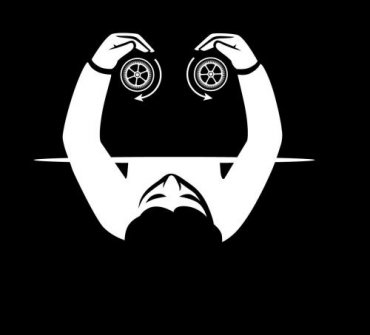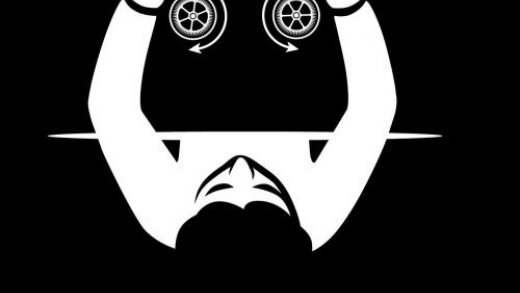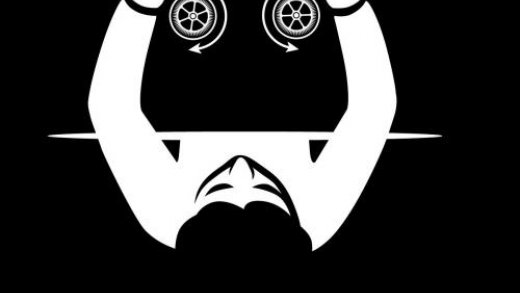During the esoteric exhibition in May 2012 (see article of Č. Zlatník Physical exhibition of Mr George Egely http://www.sisyfos.cz), a talk was given by Dr. G. Egely, the co-author of the device called "the Egely Wheel", see Fig. 1. The plastic wheel (65 mm in diameter) shown on the picture is placed on a bearing which allows, along with rotation, also for small deviations of the wheel axis from the vertical direction.
In one of the stalls this device was sold in two versions. We have acquired the cheaper one for the Czech Sisyfos Association. In esoterically aimed texts, the Egely wheel is usually referred as the first device that proves the existence of a non-physical force, to which names such as Chi, Psi, Prana, etc. are given, i.e. as a device demonstrating motion of an object by mental force, usually designated as telekinesis. The proof lies in placing a hand close to the device (see Fig. 2), which makes the wheel to spin clockwise (left hand) or counterclockwise (right hand).
In this article we examine whether the rotation of the wheel can be explained using only laws of physics. We start with the original description of the device as given by György Egely and Magdolna Dus in their Patent application [1] http://patentscope.wipo.int entitled: “APPARATUS AND METHOD FOR DETECTING EFFECTS INDICATING PHYSICAL STATE OF HEALTH AND FITNESS”.
The abstract of the patent reads:
“An apparatus for demonstrating and measuring physical effects being in connection with the general state of health and fitness of human beings, comprising a rotor arranged rotatably on a frame, of the mass 0.1 and 2.0 g, more accurately 0.3 to 0.8 g, with at least one marking on the edge being suitable for reading number of turns, wherein magnetic permeability is less than 50, furtheron optionally the rotor and the frame are connected to each other by a spring means.”
The authors of the patent also argue that:
1)the effect (i. e. the rotation of the wheel when a hand is placed near it) "cannot be replaced by artificially produced physical effects or fields of force (thermic effect, magnetic field, field of electrostatic forces etc.), none of the last mentioned yield the result as it might be achieved by the physical effect according to the invention"; that
2)“ … the physical effect according to the invention – although the nature thereof is unknown for us – in respect to the intensity of the torque or motion having been induced is staying in connection with individual natural endowments and the state in course of testing, i.e. general conditions of health and fitness and concentrating ability.”, and,
3)“… so far as torque or mechanic motion raised by the body, limbs or members of the body of a person tested can be numerically defined by reading number of revolutions and can be advantageously used for demonstrating, numerical measurement and characterizing the effect of some favourable or unfavourable (disadvantageous) circumstance changing individual natural endowments, general physical conditions or fitness of the person tested.”
In the following we will show that the main statement of the authors of the patent referred to in point (1), from which subsequently the statements in points (2) and (3) are derived, is erroneous, as the Egely wheel is in fact a heat engine, following exactly the laws of classical physics: it uses the difference between a temperature of human hand and a temperature of ambient air to transform heat energy into mechanical energy of air flow motion, which in turn drives the rotation of the wheel. Perimeter speed of the spinning wheel cannot thus be greater than the speed of the air stream that drives the wheel.
The specific propel mechanism of the wheel can be described as follows:
The air heated by contact with the surface of the hand of a living person goes up, and on its place comes the cool air from the surroundings. The unsymmetrical shape of the hand modifies this air flow so, that it comprises a component tangent to the wheel, which hits part of the wheel circumference and makes the wheel rotate. Rotation speed becomes constant, when the friction in the bearing together with the aerodynamic friction of the circumference of the wheel is equal to the driving force. Effect of the air stream on the wheel‘s spikes is similar to the effect of a stream of water pushing the blades of a Francis hydro turbine rotor. http://en.wikipedia.org
Stator of the Egely wheel that changes the direction of the air flow is the inside surface of the hand placed near the wheel. In this case it is also the source of the heat, warming the surrounding air and setting it into motion.
The thermodynamic efficiency of the conversion of heat energy into mechanical movement of the wheel is of course much smaller than the highest possible one, defined by Carnot cycle as η = ( T2 - T1 ) / T2 , where T1 is the ambient air temperature and T2 is the temperature of the hand surface. For T1 = 293.15 K (20 °C) and T2 = 308.15 K (35 °C), η = 5%. The amount of heat per second that passes under normal conditions from the whole area of a hand to the ambient air is approx. 0.5 W – 1 W http://ib.cvut.cz, and the maximum mechanical power, which could in that case be gained is equal to 25 mW – 50 mW. By a simple experiment, in which the spinning wheel is let alone without drive and one measures the gradual decrease of rotation speed caused by the aerodynamic resistance and the friction in the bearing, it could be calculated that at 30 revolutions per minute the power exerted by friction forces is equal to approx. 0.15 μW. At lower rotation speed the friction power is even smaller. (For the calculation, the wheel moment of inertia equal to 2,1·10-7 kg·m2 has been used, which comes from the measured weight 0,2 g of the plastic part of the wheel and from its mass radial distribution.) So, for compensation of the braking forces, only a tiny part of the kinetic energy of the induced air flow is needed even at a high rotational speed.
The above reasoning is supported by a short movie http://www.youtube.com demonstrating that the rotation of the wheel quickly slows down and stops, if the air flow is hindered by putting a cover over the wheel and the hand.
Conclusions:
The statement of the authors G. Egely and M. Dus in their patent application, that the observed rotation of the wheel cannot be induced by physical forces, is erroneous. The device behaves in accordance with the laws of thermodynamics, and no unknown force is needed to explain the rotation and its direction. Rotation speed of the wheel (the maximum achieved number of revolutions per minute) depends before all on the patience of the experimenting person trying to find the best position and inclination of his hand. A sizable role plays also proportion of the free space left between the hand and the wheel, the individual shape of the hand, and tightness of its position on the ground sheet. Restless movement of the hand does not provide enough time to stabilize the air flow, so agitated persons will probably achieve lower rotation speed of the wheel. The effect of rotation is better observable in a room with minimum air movement and when the disturbing effect of breath is eliminated.
No one of the results described above support the conclusions declared in the patent application (cited in points (1), (2) and (3) and later extended in particular by proponents of esotericism), namely that the rotation of the wheel should be caused by an unknown force, and that the rotation speed should be related to health conditions of the experimenting person. Of course, it can be conceded that long-term exercising and seeking the optimum position, bending and inclination of the hand, palm and fingers, can lead to improvement of the resulting effect, i.e. to higher number of revolutions per minute. However, considering the higher score as a sign of a greater life force (“vitality”), with proposed designation VQ (vitality quotient) analogical to IQ, is not justified.
Authors: Lukáš Jelínek, Luděk Pekárek
References:
[1] G. Egely, M. Dus, “Apparatus and method for detecting effects indicating physical state of health and fitness”, Patent Application No. WO/1991/008703, 27.06.1991
[2] A. K. Melikov, “Human Physiology Body’s Heat Balance”, CTU in Prague, 2010
In one of the stalls this device was sold in two versions. We have acquired the cheaper one for the Czech Sisyfos Association. In esoterically aimed texts, the Egely wheel is usually referred as the first device that proves the existence of a non-physical force, to which names such as Chi, Psi, Prana, etc. are given, i.e. as a device demonstrating motion of an object by mental force, usually designated as telekinesis. The proof lies in placing a hand close to the device (see Fig. 2), which makes the wheel to spin clockwise (left hand) or counterclockwise (right hand).
In this article we examine whether the rotation of the wheel can be explained using only laws of physics. We start with the original description of the device as given by György Egely and Magdolna Dus in their Patent application [1] http://patentscope.wipo.int entitled: “APPARATUS AND METHOD FOR DETECTING EFFECTS INDICATING PHYSICAL STATE OF HEALTH AND FITNESS”.
The abstract of the patent reads:
“An apparatus for demonstrating and measuring physical effects being in connection with the general state of health and fitness of human beings, comprising a rotor arranged rotatably on a frame, of the mass 0.1 and 2.0 g, more accurately 0.3 to 0.8 g, with at least one marking on the edge being suitable for reading number of turns, wherein magnetic permeability is less than 50, furtheron optionally the rotor and the frame are connected to each other by a spring means.”
The authors of the patent also argue that:
1)the effect (i. e. the rotation of the wheel when a hand is placed near it) "cannot be replaced by artificially produced physical effects or fields of force (thermic effect, magnetic field, field of electrostatic forces etc.), none of the last mentioned yield the result as it might be achieved by the physical effect according to the invention"; that
2)“ … the physical effect according to the invention – although the nature thereof is unknown for us – in respect to the intensity of the torque or motion having been induced is staying in connection with individual natural endowments and the state in course of testing, i.e. general conditions of health and fitness and concentrating ability.”, and,
3)“… so far as torque or mechanic motion raised by the body, limbs or members of the body of a person tested can be numerically defined by reading number of revolutions and can be advantageously used for demonstrating, numerical measurement and characterizing the effect of some favourable or unfavourable (disadvantageous) circumstance changing individual natural endowments, general physical conditions or fitness of the person tested.”
In the following we will show that the main statement of the authors of the patent referred to in point (1), from which subsequently the statements in points (2) and (3) are derived, is erroneous, as the Egely wheel is in fact a heat engine, following exactly the laws of classical physics: it uses the difference between a temperature of human hand and a temperature of ambient air to transform heat energy into mechanical energy of air flow motion, which in turn drives the rotation of the wheel. Perimeter speed of the spinning wheel cannot thus be greater than the speed of the air stream that drives the wheel.
The specific propel mechanism of the wheel can be described as follows:
The air heated by contact with the surface of the hand of a living person goes up, and on its place comes the cool air from the surroundings. The unsymmetrical shape of the hand modifies this air flow so, that it comprises a component tangent to the wheel, which hits part of the wheel circumference and makes the wheel rotate. Rotation speed becomes constant, when the friction in the bearing together with the aerodynamic friction of the circumference of the wheel is equal to the driving force. Effect of the air stream on the wheel‘s spikes is similar to the effect of a stream of water pushing the blades of a Francis hydro turbine rotor. http://en.wikipedia.org
Stator of the Egely wheel that changes the direction of the air flow is the inside surface of the hand placed near the wheel. In this case it is also the source of the heat, warming the surrounding air and setting it into motion.
The thermodynamic efficiency of the conversion of heat energy into mechanical movement of the wheel is of course much smaller than the highest possible one, defined by Carnot cycle as η = ( T2 - T1 ) / T2 , where T1 is the ambient air temperature and T2 is the temperature of the hand surface. For T1 = 293.15 K (20 °C) and T2 = 308.15 K (35 °C), η = 5%. The amount of heat per second that passes under normal conditions from the whole area of a hand to the ambient air is approx. 0.5 W – 1 W http://ib.cvut.cz, and the maximum mechanical power, which could in that case be gained is equal to 25 mW – 50 mW. By a simple experiment, in which the spinning wheel is let alone without drive and one measures the gradual decrease of rotation speed caused by the aerodynamic resistance and the friction in the bearing, it could be calculated that at 30 revolutions per minute the power exerted by friction forces is equal to approx. 0.15 μW. At lower rotation speed the friction power is even smaller. (For the calculation, the wheel moment of inertia equal to 2,1·10-7 kg·m2 has been used, which comes from the measured weight 0,2 g of the plastic part of the wheel and from its mass radial distribution.) So, for compensation of the braking forces, only a tiny part of the kinetic energy of the induced air flow is needed even at a high rotational speed.
The above reasoning is supported by a short movie http://www.youtube.com demonstrating that the rotation of the wheel quickly slows down and stops, if the air flow is hindered by putting a cover over the wheel and the hand.
Conclusions:
The statement of the authors G. Egely and M. Dus in their patent application, that the observed rotation of the wheel cannot be induced by physical forces, is erroneous. The device behaves in accordance with the laws of thermodynamics, and no unknown force is needed to explain the rotation and its direction. Rotation speed of the wheel (the maximum achieved number of revolutions per minute) depends before all on the patience of the experimenting person trying to find the best position and inclination of his hand. A sizable role plays also proportion of the free space left between the hand and the wheel, the individual shape of the hand, and tightness of its position on the ground sheet. Restless movement of the hand does not provide enough time to stabilize the air flow, so agitated persons will probably achieve lower rotation speed of the wheel. The effect of rotation is better observable in a room with minimum air movement and when the disturbing effect of breath is eliminated.
No one of the results described above support the conclusions declared in the patent application (cited in points (1), (2) and (3) and later extended in particular by proponents of esotericism), namely that the rotation of the wheel should be caused by an unknown force, and that the rotation speed should be related to health conditions of the experimenting person. Of course, it can be conceded that long-term exercising and seeking the optimum position, bending and inclination of the hand, palm and fingers, can lead to improvement of the resulting effect, i.e. to higher number of revolutions per minute. However, considering the higher score as a sign of a greater life force (“vitality”), with proposed designation VQ (vitality quotient) analogical to IQ, is not justified.
Authors: Lukáš Jelínek, Luděk Pekárek
References:
[1] G. Egely, M. Dus, “Apparatus and method for detecting effects indicating physical state of health and fitness”, Patent Application No. WO/1991/008703, 27.06.1991
[2] A. K. Melikov, “Human Physiology Body’s Heat Balance”, CTU in Prague, 2010






